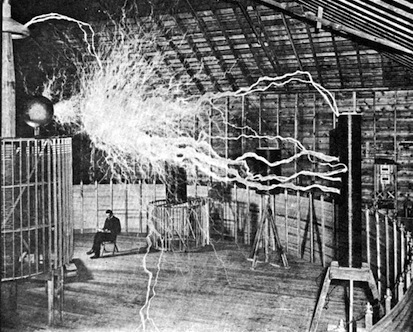Be Golden as gold mine & Green as leaf
carpe diemBe Golden as gold mine & Green as leaf
carpe diemMad Scientists of the Modern Age: Nikola Tesla
Mad Scientists of the Modern Age: Nikola Tesla

What is the first image that pops into your mind when you hear the phrase "mad scientist"? Quite possibly (unless you chose the "mad chemist" wielding test tubes and Erlenmeyer flasks of frothing liquids) it is an eccentric early-twentieth century man, in a lab full of enormous electrical machinery. Sparks fly, leaping from the equipment around him while he intently fiddles, impervious to the fiery danger. He works all night in a cavernous lab crowned by an electrical tower and lit only by dim bulbs and occasional arcs of electricity. He almost never sleeps. He hopes to build death-rays, create earthquakes, revolutionize the world.

You've just envisioned Nikola Tesla. Yet, he was not as mad as we picture him.
Before
we delve into Tesla's crazier aspects, it is important to pause and
recognize how brilliant he was and how important his work is to the
quality of life that we enjoy today.

Edison's light
bulb is trumpeted as the signal achievement beginning the electrical
era. However, it was Tesla who devised most of the alternating current
(AC) electrical systems that the world's power grids are modeled upon.
He single-handedly patented AC electrical generators, transformers,
power lines, and motors. The electrical system formed by these devices proved so much superior
to Edison's direct current (DC) electrical system that it was adopted
universally across the globe. This was despite Edison's public relations
battle, which included the invention of the electric chair and the public electrocution of animals.
Tesla
was in many ways the opposite of Thomas Edison. Edison was never known
as a brilliant man, but as a methodical, determined one. "Genius is 99
percent perspiration and one percent inspiration," he once said. Tesla
was a nearly unparalleled genius, but lacked the business intuition and
common sense of Edison. Edison died rich and one of most famous men in
the world, while Tesla died penniless and alone, feeding pigeons.

Tesla's
legacy includes the first working large-scale hydroelectric power
station, and the first remote control demonstration. (A remote control
toy boat, but still.) Tesla was also among the first scientists in the
world to take X-rays, to design a fluorescent lightbulb, and (probably
the first) to discover the ideas of radio transmission and radar. He
wirelessly lit lightbulbs several feet away and found experimental hints
of the resonant frequencies of the earth's atmosphere, which were not to be theoretically and experimentally validated for another 50 years. He died owning roughly 300 patents.
After
years of wildly successful invention, Tesla began to lose his way,
making grandiose, eccentric and sometimes completely impossible claims.
He fervently spoke of building a "teleforce weapon" capable of melting
steel wirelessly from 200 miles away. Upon his death, a box supposedly
containing a death ray part was found to contain only a basic piece of
old equipment.
Tesla believed that he could
create a camera to project a brain's thoughts onto a wall. He built a
187 foot-tall tower to try to wirelessly convey electric power across
the planet, using the earth itself as an enormous electrical conductor.
He wanted to harness the entire sphere of the Earth as a power line!
Upon picking up odd signals at one of his labs, Tesla believed that they
could have been sent from Mars by using that planet similarly as a
conductor.
Celibate his entire life, Tesla
became lonely and slightly paranoid in his elder years. He claimed to
keep his ideas inside of his brain to keep them from being stolen. He
was suspicious of twentieth century physics, as explained by Einstein
and others. OCD traits began to hamper him: he could not tolerate round
objects, human hair or touching things that might have germs. He was
supposedly obsessed with the number three.
Tesla's reputation has grown through many tall-tales:
he allegedly caused an earthquake; it was said that he could fell steel
buildings and bridges with a pocket-sized machine; he allegedly
transmitted electricity 26 miles without wires. It is disappointing that
these stories are almost categorically untrue. However, the simple fact
that they exist and, like most myths, do have some far-diminished basis
in reality is proof of the man's legend. Wireless electrical energy
over seven feet became 26 miles and eventually "free energy" from the
vacuum.
An entire conspiracy theory movement
has formed around Tesla's "hidden" or "suppressed" inventions and ideas.
The United States government also unwittingly contributed to Tesla's
legacy of mad genius. Shortly after his death in 1943, the FBI seized
all of his belongings.
Nikola Tesla never
created free energy from thin air. He neither created earthquakes nor
built a death ray. He did however, make enormous contributions to the
world, leaving us with a fascinating historical character, and some beautiful lightning machines.